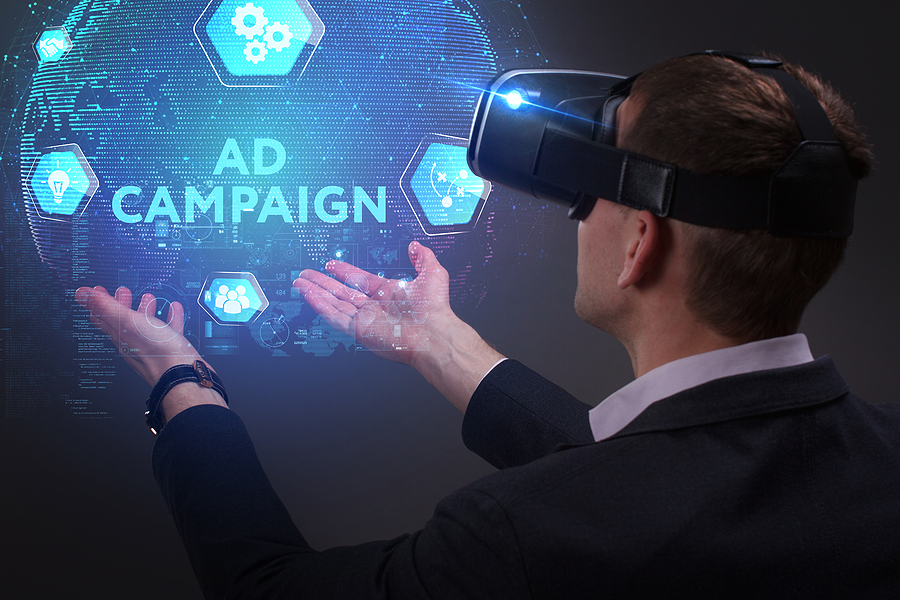by: Ron Van Herk
Virtual Reality advertising usually has a much higher success rate compared to traditional advertising formats. A research study showed that VR advertising gaze through rate (GTR) had a 29.8% success rate compared to 1% CTR for mobile and 0.4% CTRs for desktop ads [webfx.com]. VR advertising is different than traditional broadcast and Internet advertising. VR Ads can have a much higher impact and success rate because of the viewers immersive attention. Unfortunately, setting up ads and working with VR advertising networks can be complicated and have costly mistakes. This article helps you to learn VR advertising options, key benefits and implementation options
Virtual Reality (VR) Advertising Suprises
Companies who advertise using virtual reality (VR) often are surprised about the high success rate and complexity of the new advertising medium. Key VR advertising surprises include high engagement levels, emotional memory impact, VR advertising technical challenges, new skills requirements, higher VR advertising costs and new data and analytics insights.
High VR Advertising Engagement Levels
VR advertising has a high level of user engagement. Users often spend significantly more time interacting with VR ads compared to traditional advertising formats. This increased engagement can lead to greater brand awareness, memorability, and positive brand associations.
Emotional Memory Impact
VR advertising can have a strong emotional impact on users which creates memorable experiences that resonate with audiences on a deeper level. High emotional impact can develop strong brand affinity and recall.
VR Advertising Technical Challenges
Creating and deploying VR ad campaigns can be complicated (not always). Developing high-quality VR content requires specialized skills and resources, and companies may face unexpected hurdles related to content production, optimization, and compatibility with different VR platforms and devices. These technical challenges can be overcome by using VR advertising networks or working with VR platforms that have good support for advertisers.
New Skills Requirements
The setup of VR advertising may require a significant learning and setup curve. The unique characteristics of VR, such as spatial design, user interaction, and immersion, requires experimentation and iteration skills. Companies may need to invest time and resources in training and upskilling their teams to effectively leverage VR for advertising purposes.
Higher VR Advertising Costs
VR advertising can be more expensive to produce compared to traditional advertising formats. Companies may be surprised by the initial investment required for content creation, technology infrastructure, and distribution channels. However, the long-term benefits of VR advertising, such as increased engagement and brand impact, justify the upfront costs.
Data and Analytics Insights
VR advertising offers and interactions can be tracked providing details on behavior and campaign performance within VR environments. While VR analytics tools are available, they may not offer the same level of granularity and accuracy as traditional digital advertising platforms. Companies may need to develop new strategies for measuring ROI and optimizing VR ad campaigns based on available data.
Virtual Reality (VR) Advertising Types
Key types of VR ads include in-app advertising, branded VR experiences, virtual product placement, virtual reality sponsorships, 360 degree ads and interactive ads.
In App Advertising
In app advertising involves inserting or placing branded content or advertisements within virtual reality experiences. Companies can insert media segments (interrupt viewing content), sponsor billboards, in-game objects, or even create branded mini-games within larger VR experiences. This type of advertising allows brands to reach highly engaged audiences while they are actively participating in an immersive experience.
Branded VR Experiences
Branded VR experiences are content that enables users to interact with their products or services in a virtual environment. For example, a car manufacturer could create a VR showroom where users can explore different car models, customize features, and even take a virtual test drive. These experiences offer a unique way to showcase products and create memorable brand interactions.
Virtual Product Placement
Virtual product placement allows companies to replace or insert product or service images within VR content. For example, a virtual reality travel experience could include branded products such as luggage, clothing, or accessories. Virtual product placement allows brands to integrate seamlessly into the virtual environment, reaching consumers in a non-intrusive way.
Virtual Reality Sponsorships
Virtual Reality sponsorships allow companies to support VR content creators, developers, or platforms to sponsor virtual reality experiences or events. This may involve sponsoring VR games, virtual concerts, or other immersive experiences that align with the brand’s target audience and messaging. Virtual reality sponsorships offer brands visibility and exposure within the VR community while supporting the development of innovative VR content.
360 Degree Video Ads
360-Degree Video Ads provide promotional content in a 360-degree panoramic format, immersing them in the environment. Brands can create interactive 360-degree videos that showcase their products or tell a story. Users can explore the video by moving their head or device, providing a more engaging experience compared to traditional video ads.
Interactive Advertising
Interactive advertising enables users to engage with branded content through actions such as clicking, tapping, or interacting with objects within the virtual environment. Brands can create interactive ads that allow users to explore products, play games, or participate in virtual experiences. Interactive advertisements increase user engagement and provide valuable data insights for advertisers.
Virtual Reality (VR) Advertising Systems
Virtual reality (VR) advertising platforms and services manage how brands and advertisers can create, distribute, and measure VR advertising campaigns. VR advertising systems include VR content creation platforms, VR advertising networks, branded VR experience platforms, VR social platforms and VR measurement and analytics tools.
VR Advertising Networks
VR advertising networks act as intermediaries between advertisers and VR content creators or publishers. They provide a marketplace where advertisers can purchase ad space within VR experiences and reach target audiences across a network of VR apps, games, and platforms. These networks often offer targeting options, ad formats, and performance analytics to help advertisers optimize their campaigns. Examples include Vertebrae and Advir.
VR Ad Server Platforms
VR ad serving platforms deliver targeted advertisements within VR experiences based on user behavior, preferences, and demographics. They use advanced targeting algorithms and real-time bidding systems to optimize ad delivery and maximize campaign performance. These platforms may support various ad formats, including 360-degree videos, interactive ads, and in-game placements. Examples include OmniVirt and Admix.
VR Content Creation Platforms
Companies, media agencies and developers can create immersive VR content that includes ad content and ad network insertion options. VR creation platforms can setup drag-and-drop interfaces, use pre-built templates and interactive elements to simplify the content creation process. Examples include Unity, Unreal Engine, and Adobe Aero.
Branded VR Experience Platforms
Branded VR experience platforms can allow advertisers and media agencies to create custom branded VR experiences. They offer end-to-end solutions for designing, developing, and deploying VR campaigns, including interactive demos, virtual showrooms, and immersive brand activations. Brands can work directly with these platforms to create unique VR experiences that align with their marketing objectives. Examples include Emblematic Group and Innoactive.
VR Social Platforms
VR social platforms enable users to connect and interact with each other in virtual environments. These platforms often support user-generated content, virtual events, and social interactions, creating opportunities for brands to engage with consumers in immersive social experiences. Brands can sponsor virtual events, create branded environments, or host interactive experiences to connect with audiences in VR. Examples include VRChat and AltspaceVR.
VR Measurement and Analytics Tools
VR Analytics and Measurement Tools: VR analytics platforms provide insights into the performance and effectiveness of VR advertising campaigns. They track key metrics such as impressions, engagements, click-through rates, and conversions to help advertisers understand campaign impact and ROI. These tools often integrate with VR content creation platforms and advertising networks to provide comprehensive campaign analytics. Examples include Retinad and Admix Insights.
Ron Van Herk
 Ron Van Herk is the CEO and co-owner of Cybermedia Television in the Netherlands. He is the innovator behind several breakthrough production, streaming, and distribution systems. Ron has set up, run and created branded remote production systems for shows, live events and other media production activities, including world Police and fire games, the HighScope Foundation’s annual conference and more.
Ron Van Herk is the CEO and co-owner of Cybermedia Television in the Netherlands. He is the innovator behind several breakthrough production, streaming, and distribution systems. Ron has set up, run and created branded remote production systems for shows, live events and other media production activities, including world Police and fire games, the HighScope Foundation’s annual conference and more.
Website: Cybermedia TV

